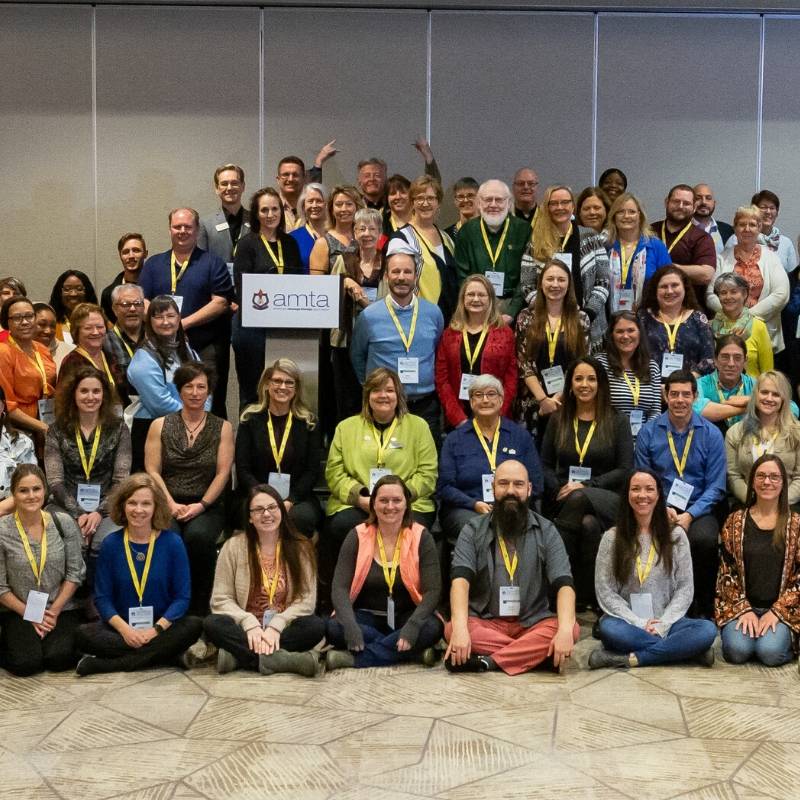
Starting Your Massage Career
Discover what you need to know about becoming a massage therapist.

One of the most frequent comments massage therapists make about their occupation is, "I feel fortunate to have found work I love." They feel this way because a career in massage therapy allows them to help people in a meaningful way with a high degree of personal contact.
Are you ready to explore a career as a massage therapist? AMTA School Members offer a minimum of 500 in-class hours to ensure the highest quality massage therapy education.
Are you an AMTA School Member? Learn how to list your school.

Massage Therapy is a Growing Career
As massage therapy has become increasingly important in the health and wellness professions, the number of massage therapists has risen. In 2019, the estimated number of massage therapists in the US was 360,823, statistically flat from 2018.
There are currently 245+ accredited massage therapy institutions in the United States. Many institutions have multiple campuses. Find an AMTA School Member near you. Training programs in massage therapy generally require a high school diploma, though post-secondary education is useful. Learn what to consider when looking for your perfect massage therapy program. Previous studies in broad subjects such as science (especially anatomy and physiology), business and humanities are helpful.
Related: CONSUMER USE OF MASSAGE THERAPY
Massage Therapy is a Flexible Career
There is no such thing as a standard massage therapy practice. One of the reasons individuals choose this profession is because of the flexibility it offers in terms of work hours, independence, and choice of practice locations and types.
Massage therapists can work full time or part-time. Massage therapists spend additional time on things like scheduling, billing, housekeeping and marketing, to name a few.
Income levels for massage therapists vary by region of the country, experience and type of practice.
Related: Massage Therapy Industry Fact Sheet

Massage Therapy is a Flexible Career
There is no such thing as a standard massage therapy practice. One of the reasons individuals choose this profession is because of the flexibility it offers in terms of work hours, independence, and choice of practice locations and types.
Massage therapists can work full time or part-time. Massage therapists spend additional time on things like scheduling, billing, housekeeping and marketing, to name a few.
Income levels for massage therapists vary by region of the country, experience and type of practice.
Related: Massage Therapy Industry Fact Sheet
Settings
Massage therapists practice in a variety of settings and locations and in a variety of contractual arrangements. These can include:
- massage office
- office in home
- physicians' offices and clinics
- franchises
- hospitals and wellness centers
- nursing homes/hospice
- chiropractic offices
- on-site (chair massage in offices, airports and at public events, for example)
- health clubs and fitness centers
- sports teams and events (amateur and professional)
- hotels
- spas and resorts
- salons
- cruise ships
While massage therapists work in a variety of work environments, sole practitioners account for the largest percentage of practicing therapists at 76%.
Of this group, 56% work at least part of their time at a client's home/business/corporate setting, 25% in a health care setting, 24% in a spa setting and 29% at their home. Refer to the Industry Fact Sheet for more data.
Learn more about massage therapy workplace options with our free downloadable career guides.
Career Path Quiz
Discover which massage therapy work environment may be the best fit based on your interests, preferences and work styles with the American Massage Therapy Association's Career Path Quiz. Your answers will guide you to work settings that likely suit you and, more importantly, make for a successful and enjoyable career in massage therapy.
How to Become a Massage Therapist
STEP 1
Complete a Training Program
Find a training program at a massage therapy school that will qualify you to practice in the location you choose.
Step 2
Meet the Requirements of Your State or Municipality
Make sure you meet your state or municipality's requirements for practicing massage, such as obtaining a license or other credential.
Step 3
Prepare for the MBLEx
Use our free test prep app to prepare for the Massage & Bodywork Licensing Examination (MBLEx).
Accreditation of Schools and Programs
Accreditation of a school or program by the United States Department of Education (USDE) ensures the education provided meets an accepted level of quality training.
Several accrediting bodies offer voluntary accreditation of massage programs and/or schools including the Commission on Massage Therapy Accreditation (COMTA), the National Accrediting Commission of Arts and Sciences (NACCAS), the Accrediting Commission of Career Schools and Colleges (ACCSC), and the Accrediting Bureau of Health Education Schools (ABHES).
Massage Laws and Regulations
Most states currently regulate massage and several others are moving toward statewide regulation/licensing. Most states require a minimum number of hours of training, passing an exam to demonstrate competency (for instance, passing the MBLEx), and continuing education to practice. The MBLEx is administered by the Federation of State Massage Therapy Boards.
CREDENTIALS FOR THE MASSAGE THERAPY PROFESSION
STATES AND THEIR REGULATION OF MASSAGE THERAPY
Board Certification
Board certification can be obtained from the National Certification Board for Therapeutic Massage and Bodywork (NCBTMB) and indicates that a massage therapist has attained a higher level of achievement beyond entry level licensure. Board certification is the highest voluntary credential available to massage therapists.
For more information, visit the NCBTMB website.

The Importance of Joining a Professional Association
The American Massage Therapy Association is a nonprofit professional association created in 1943 by massage therapists, for massage therapists. Its mission is to serve its members while advancing the art, science and practice of massage therapy. The association requires its members to abide by its Code of Ethics and Standards of Practice.
Join the Largest Nonprofit Community of Massage Therapists
As the largest nonprofit professional association serving massage therapists, massage students and schools, AMTA invests membership dollars back into the profession through research, advocacy and promotion of the health benefits of massage. No other company or organization in the profession gives back as much.